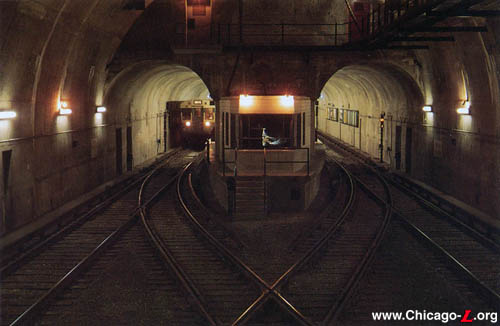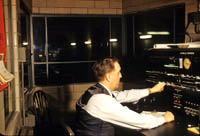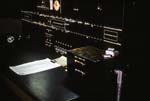
A Logan Square train stops
at the LaSalle station just two months after it opened,
looking west from the LaSalle interlocking just east of the
station in April, 1951. LaSalle was the end of the line
until 1958 when the connecting Congress Line was completed,
so trains turned through the diamond crossover to make the
trip back to Logan
Square. For a larger
view, click here.
(Photo from the Krambles-Peterson
Archive)
|
LaSalle
Interlocking
LaSalle Street and
Congress Parkway, Loop
Service
Notes:
|
Services:
|

|
Blue Line:
Milwaukee-Dearborn Subway
|
Quick Facts:
Established: February 25,
1951
Original Line: Milwaukee-Dearborn Subway
Rebuilt: n/a
Status: In Use
Profile:
LaSalle Interlocking was installed as part of the construction of
the Milwaukee-Dearborn
Subway, which initially ended at LaSalle/Congress
station when it opened in 1951. Although the subway was intended to
be continued west and LaSalle
station was meant to eventually serve as a through-station, for the
time being it had to serve as a single island platform, two track
stub terminal. As such, a crossover had to be installed to control
such a terminal, even if it was only meant to be actively used until
such time as the subway was extended west.

The towerman at LaSalle Tower is working the panel, routing trains in and out of the terminal, in this view circa 1951. While more common at the time, shirt-sleeves, a tie, and vest gave way long ago as the typical attire for a towerman! For a larger view, click here. (Photo by J.R. Williams, courtesy of the Krambles-Peterson Archive) |
LaSalle Interlocking is located immediately east of LaSalle/Congress
station and controlled the movements in and out of the Congress
Street Terminal station, as it was sometimes called in the
mid-1950s. The plant consisted of a tower on the west side of the
junction and a diamond crossover in approach to the two-track stub
terminal. The interlocking -- a group of switches, track trips, and
signals arranged to prevent conflicting train moves -- at LaSalle
crossover was initially controlled manually from the control panel
located in LaSalle Tower.
One of the CTA's first
automated route-selection plants at a junction was installed at
LaSalle Interlocking in February 1953. The selection programming
worked like so: Inbound routing was based on which track was
unoccupied, with preference given to the south pocket if both tracks
were empty. Because the south pocket was, in fact, the northbound
track (outside of the terminal, and would be once LaSalle
became a through-station), trains in this pocket could depart the
station and begin the trip to Logan
Square on the northbound track without crossing over in the
interlocking and thus did not risk fouling the line. Outbound routing
was simply on a first-come, first-served basis triggered by an
automatic train dispatching program in the tower about a half-minute
before scheduled departure time. This departure program actually
overrode the plant so that departures would not be delayed if a train
arrived at the same time. The tower panel and necessary equipment was
still left in place for manual operation of the interlocking when
desired, such as in rush hour, emergencies, or other unusual
circumstances.
On July 13, 1957, a severe storm struck Chicago, but the drainage
system of neither the new Congress Expressway or the rapid
transit line in its median, both under construction at the time,
were not yet operational. With the Congress
Line connecting to the subway just east of Halsted,
a torrent of water rushed into the tunnels of the Dearborn
Subway. Although the subway was equipped with automatic pumping
equipment, it couldn't handle the flow. LaSalle is near the low-point
of the subway (though the lowest is actually between LaSalle
and Clinton
stations, west of the interlockings) and so with the water level
settling at Jackson
station to the northeast, LaSalle Interlocking found itself
underwater!!! The water was so high that its high-point filled half
the interior height of LaSalle Tower and up to the archway soffit of
the columns along the platform edges of LaSalle
station. Service was truncated back to Jackson
and LaSalle Interlocking was water-logged until days later when
cleanup was completed.
On June 22, 1958, the new Congress
Line opened for operation. Douglas
trains were withdrawn from the Loop
and rerouted to downtown via the Congress
Line, which were both through-routed with the Milwaukee
Elevated via the Milwaukee-Dearborn
Subway, creating the new West-Northwest
Route. At this point, LaSalle
became a through-station and LaSalle Interlocking was no longer
needed in daily scheduled service, since the station no longer acted
as a two-track stub terminal. All trains now operated straight
through LaSalle in both directions on their respective tracks. At
this time, staffing was withdrawn from LaSalle Tower, although it
still exists today.
The 1950s interlocking control panel remained
in place until the signals and associated equipment were replaced circa 2007-08 as part of the Blue Line Traction Power and Signal System Upgrade Project. LaSalle Interlocking is still extant and is occasionally
used for single-tracks and other special or emergency operations.

 |
lasalle02.jpg (106k)
This detailed view of the original LaSalle Tower panel, seen on March 24, 1951, shows the machine when it was brand new and the latest technology in electrically-controlled interlocking tower panels. Note the clock and other details included in the panel face. Also note that the panel graphic includes the line continuing west of LaSalle and even includes Clinton station -- neither would exist for several more years after the panel installed and this photo was taken. The pack of cigarettes and books of matches sitting on the "next train" indictor box for the terminal are a reminder of how commonplace it once was to smoke even in workplaces. (Photo by B.L. Stone, courtesy of the
Krambles-Peterson Archive) |

|
lasalle-congress02.jpg (114k)
On July 13, 1957, a severe storm struck and
Chicago, but the drainage system of the new Congress
rapid transit line was not yet operational. A torrent of
water rushed into the tunnels of the Dearborn
Subway, settling at Jackson
station. LaSalle was water-logged until days later when
cleanup was completed. (Photo from the
Krambles-Peterson Archive)
|






